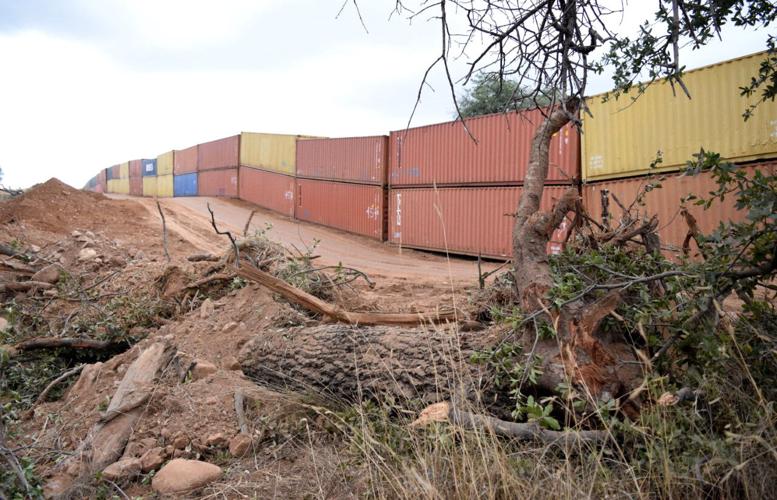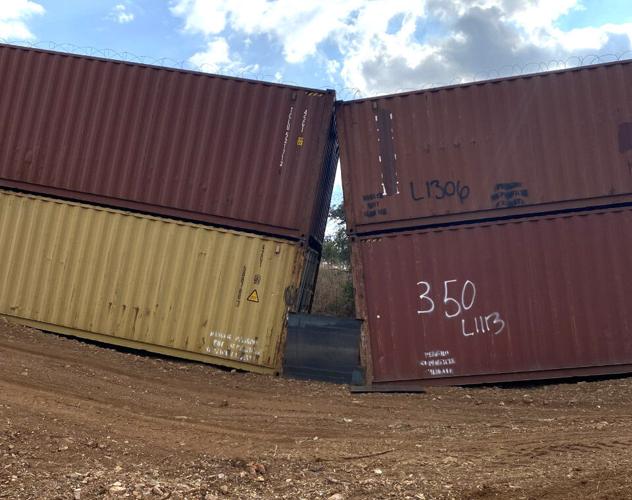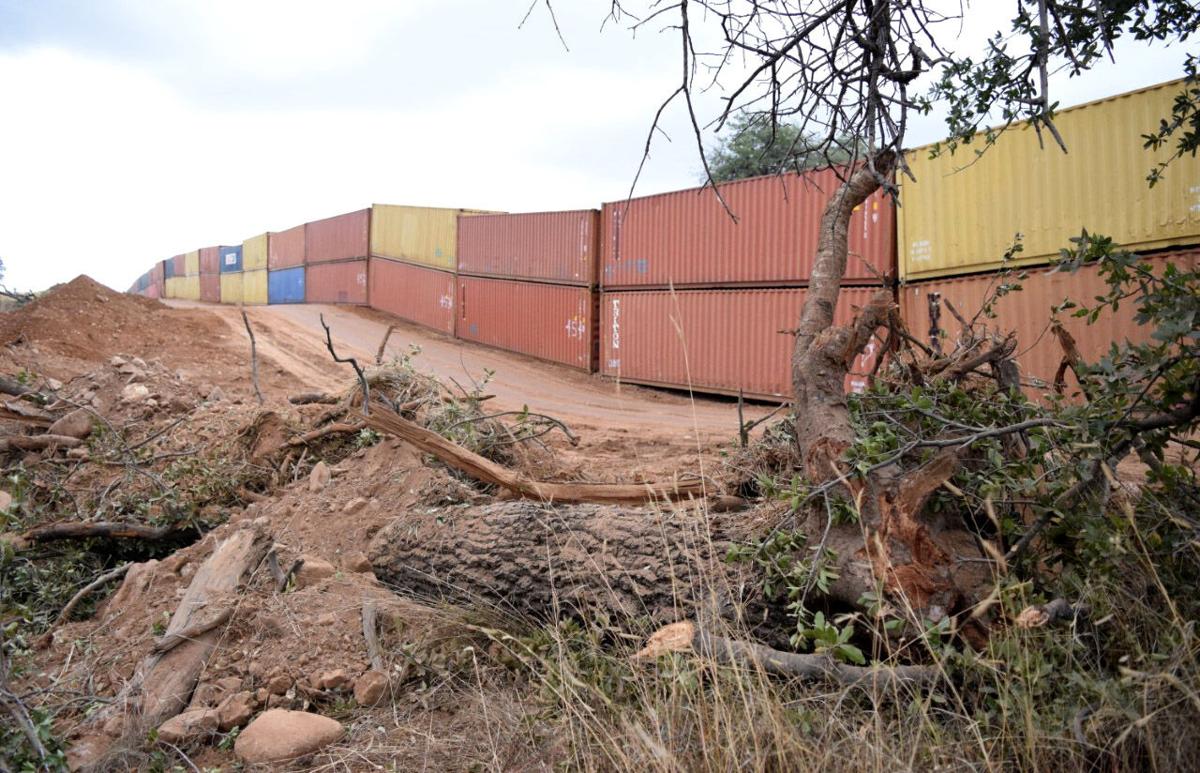A small group of protestors has nearly brought the governor’s border barrier construction on national forest land in Southern Arizona to a standstill — even when contractors tried working in the middle of the night.
“Politics aside, what this is doing to the wildlife corridor, what this is doing to the environment, is a travesty, is horrific,” said Kate Scott. She runs the nonprofit Madrean Archipelago Wildlife Center, which works to restore and preserve wildlife areas, and has spent numerous days in Coronado National Forest in Cochise County, protesting the barrier construction about 90 miles southeast of Tucson.
Republican Gov. Doug Ducey’s project began unauthorized placement of double-stacked shipping crates there in October and has since built a border barrier that stretches nearly 4 miles long, despite the federal government telling him at least twice to stop.
Ducey’s response was to file suit against federal agencies, challenging their jurisdiction over part of the land. The lawsuit says the state is being “invaded” and the U.S. government is not living up to its legal obligation to offer protection, which he contends means the state is entitled to take matters into its own hands.
Lawyers for the federal government recently asked a judge to dismiss the case, arguing Ducey’s lawsuit is “flawed on so many fronts” that it should not be allowed to proceed.
The new border wall made of double-stacked containers numbered almost 1,000 containers last week and stretched almost four miles. Video by Tim Steller/Arizona Daily Star
The Governor’s Office has said it intends to complete a 10-mile stretch, which could cost as much as $95 million in taxpayer funds. Ducey leaves office at the end of the year and will be succeeded by Democrat Katie Hobbs, who told Capitol Media Services she will put an end to the construction.
The barrier is meant to stop migrants from entering the country, but because the land there is not flat, there are numerous large gaps, which are easy to walk or climb through. Some of the gaps have been covered with a patchwork of metal and some are wide open. There is also a large opening where the land drops off into a creek.
Conservationists say the state’s barrier blocks migration and connectivity for wildlife while not stopping humans who can easily find the gaps and go around the barriers.
Scott, who lives about 40 miles northwest of where the barrier is going up, was one of the first to come out to protest, on Nov. 29. That was the first day the small group of mostly local people stopped the construction by standing in front of where contractors were placing the crates and where the excavators were widening the road that runs along the border, Scott said.
Running the length of the shipping-crate barrier are dozens of mature oak trees that have been broken and uprooted, tossed into a ditch by the road. Others that are still standing have branches torn off and gashes cut into them.
At first, the group of protestors, which varies daily between four to about a dozen people, only stayed to block construction during work hours, until they realized the contractors had started working at night. Now people are there to stand in front of working construction vehicles at any time of day or night.

Shipping containers placed by the state of Arizona along the Arizona-Mexico international border on Coronado National Forest land south of Sierra Vista in December 2022.
Protestors recently stopped work by standing in the way of vehicles in the middle of the night, not moving while one driver of a bulldozer drove so close to the people protesting they were touching the machinery.
Bill Scheel drove down from Phoenix to protest. He was previously hiking in the area with his son when they saw the trucks carrying the shipping crates.
“What’s neat is how our presence here has almost completely shut it down,” Scheel said. “We’re obeying the law. They’re the ones who are disobeying the law.”
Ducey has not been out to see the new barrier, said his spokesman C.J. Karamargin. He has been to see the similar barrier he had built in the Yuma area, and members of the governor’s team are out in Cochise County regularly, Karamargin said.
The Governor’s Office wouldn’t comment on the number of demolished oak trees or the numerous gaps in the barrier that are large enough for people to crawl or walk through.
“The first priority is public safety,” Karamargin said when asked about the protests. “Nothing will be done to endanger public safety, either the people who were there protesting or the work crews. But work is continuing when it can. It’s not at a complete standstill.”
With the people protesting there around the clock, no crates have been added to the barrier since the middle of the night Monday.
The U.S. Forest Service warned visitors to the public land, including hunters, that Arizona’s project is creating safety hazards, in a statement last week, which also said the presence of the containers is unlawful.
Special project: Immigration manipulation
This is an investigative project by Arizona Daily Star metro columnist Tim Steller about how government actors in the U.S. and other countries try to mold public opinion on immigration and the U.S.-Mexico border. It is funded by a fellowship from the Society of Professional Journalists Foundation. The Star is publishing these investigative columns periodically in 2020.
Armed groups have forced thousands of people from their homes in Guerrero and neighboring states, many heading to the U.S. border, but the Mexican government that acted so dramatically against foreign migration has done little to help its own refugees.
While some whole villages have fled from armed groups, another, less noticed migration is taking place one family at a time
On Mexico trip, columnist Tim Steller attends Mexican president Andrés Manuel López Obrador's press conference, finds a secret to getting called to ask a question.
Steller's take: The border is Douglas, Arizona's main economic advantage, but it becomes a disadvantage when America's loudest voice, and even the local sheriff, proclaim it dangerous.
The president and allies hyped the threat posed by infected people crossing the border illegally, saying the border wall would stop them. The real threat was from normal social interactions that continued in the absence of a coordinated, border-wide public-health response.
U.S. prosecutors accuse Honduras President Juan Orlando Hernandez of involvement in cocaine trafficking, and some migrants say his policies drove them from the country. But Hernandez has kept President Trump and his administration happy by catering to their interests.
Many Hondurans who fled to the United States in 2018-2019 blame Pres. Juan Orlando Hernandez's government, but Santos Yovany Membreño is a loyal supporter. He worked for a program that intended in part to prevent migration. It led him to seek asylum.
They were just enforcing the law, not deliberately taking kids from their parents, administration officials claimed. That and other lies justified the policy that caused a scandal in early 2018. The policy seemed to have died, but family separation lives on.
Trump pumped up the threat of foreign criminals to win the GOP primary and presidency in 2016. That rhetoric gave him the power to slash legal immigration and impose harsh border-security measures.
Trump's border wall began as a marketing idea by an adviser who had never been to the U.S.-Mexico line. When people cheered, the words turned into a promise to Trump's supporters and, finally, a physical reality across Arizona's wild lands.















